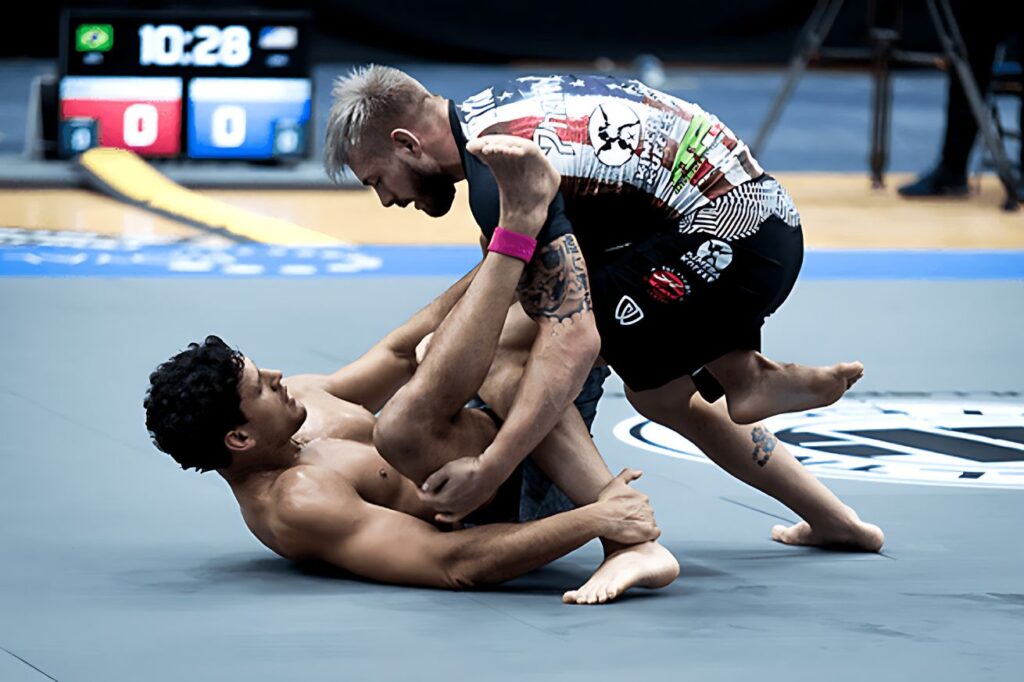
Are you ready to dive into the exciting world of jiu-jitsu matches in Brazil?
In order to improve your game or get started on the mats for the first time, you need to know how to score points.
To get those points and win, this is the guide you should follow.
What Is the BJJ Scoring Points System?

When it comes to Brazilian jiu-jitsu, points are valuable. As long as no one scores a submission, they decide who wins the match.
When you know everything there is to know about the point system, you can focus on the best ways to beat your opponent.
IBJJF and SJJIF Jiu Jitsu Points System
There are some small differences in the rules between groups, but the main ones are always the same.
In tournaments put on by the International Brazilian Jiu-Jitsu Federation (IBJJF) and the Sport Jiu-Jitsu International Federation (SJJIF), here’s how to score:
| Dominant Position or Techniques | Scored Points |
| Back mount / Back control | 4 |
| Full Mount | 4 |
| Guard Passing | 3 |
| Knee-on-Belly | 2 |
| Sweep | 2 |
| Takedown | 2 |
ADCC Points Scoring System

Abu Dhabi Combat Club (ADCC) focuses on submissions more than anything else, but in the later stages of a match, scoring points is very important.
You score after the first half of the game in this way:
| Dominant Position or Techniques | Scored Points |
| Passing the guard | 3 |
| Knee on stomach | 2 |
| Mount position | 2 |
| Back mount with hooks | 3 |
| Takedown ended in a half guard | 2 |
| Sweep ended in a half guard | 2 |
| Clean sweep ending with guard passing | 4 |
| Clean takedown ending with a guard pass | 4 |
NAGA BJJ Scoring System
There are gi and no-gi tournaments around the world put on by the North American Grappling Association (NAGA). The scoring system includes:
For Gi:
- 2 points: Successful takedown, sweep
- 3 points: Guard passing
- 4 points: Mount, back control
For No-Gi:
- 1-2 points: Submission attempts, takedowns
- 2 points: Sweeps, side control, mount, back mount, knee on belly
Key Strategies to Score Points in BJJ Tournaments
In BJJ, scoring is not just about having the most points; it is also about being in charge of the fight. Here are some great moves that will help you score:
- Takedowns are a classic way to drop your opponent on the mat and get two points.
- Guard Passing: Get past your opponent’s legs to take control of their upper body and score three points.
- Sweeps: Flip the script by moving from the bottom to the top position, scoring 2 points.
- Back Control: Dominate from the back for a clear path to both control and potential submissions, adding 4 points to your score.
- Mount: Secure this strong position to open up numerous submission opportunities and earn 4 points.
- Knee-on-Belly: This pressure-heavy position earns you 2 points and can set up further attacks.
Related: Prove your mastery of Brazilian Jiu-Jitsu with our Ultimate Quiz! Test your knowledge of techniques, famous fighters, and more. Start the challenge now!
Final Thoughts
In jiu-jitsu competitions, scoring is not just about winning; it is also about showing off your skills and getting better at controlling your opponent.
Pay attention to these ways to get points to win. They will help you get better at jiu-jitsu for future matches.
Do well on the mats by remembering these tips, whether you are training for a tournament or just want to get better.

Are you ready to explore the depths of MMA and Jiu-Jitsu? Get insider stories, fight breakdowns, and mindset gems delivered straight to your inbox. Subscribe Now!
◣ Read Next ◥



